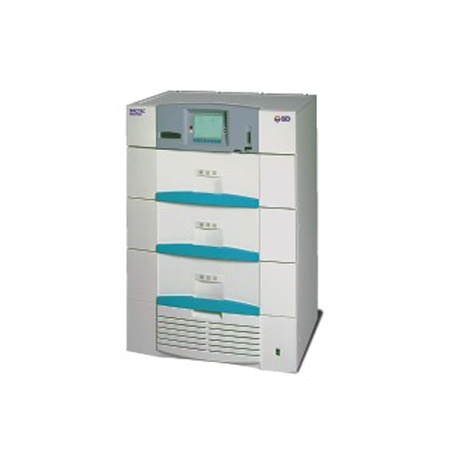BD Bactec™ MGIT™ 960

Bacteriological analyzer BD Bactec™ MGIT™ 960 1. automated modular system (presence of 3 sections) for testing and culture control system, designed for in vitro diagnosis of mycobacteria from clinical samples: sputum, bronchial washings, pleural exudate, synovial and cerebral fluids and determining the sensitivity of mycobacteria to drugs of the 1st line ( streptomycin, isoniazid, rifampicin, ethambutol, pyrazinamide);
2. Automatic, continuous culture testing using non-invasive and non-radiometric technology. The frequency of measurements of incubated tubes is 1 time per hour.
3. collection and processing of samples in special test tubes with a volume of 7 ml;
4. the presence of a photodetector in the device that measures the level of fluorescence depending on the amount of oxygen consumed by the microorganism during growth, reading the results every 60 seconds;
5. the possibility of registering a positive culture by means of a light indicator on the front panel of the section, turning on the sound signal, as well as indicating the station number and displaying it on the liquid crystal display;
6. Possibility of simultaneous testing of 960 samples for the presence of Mycobacterium tuberculosis in the medium;
7. Mycobacteria detection time from 5 to 14 days;
8. the average time for determining sensitivity to anti-tuberculosis drugs is 7-9 days;
9. the maximum protocol of the study for detection is not more than 42 days;
10. the maximum duration of the drug sensitivity study is no more than 28 days
11. the presence of a barcode scanner to scan the barcode of the test tube when it is identified;
12. the presence of a floppy disk for updating software and saving data for system diagnostics and error correction;
13. Availability of a system computer in the upper section of the device to control the positivity of test tubes, control the system, save data and user interface;
14. the presence of an external port on the rear panel for connecting to a printer;
15. the presence of system software that displays all functions, operations and settings;
16. availability of built-in software testing for continuous monitoring of the operation of the electrical and optical components of all detectors simultaneously. This function allows automatic monitoring of the main operating characteristics of each detector;
17. the possibility of automatic calibration of the system.
Bactec MGIT 960 is an automated modular system designed for in vitro accelerated bacteriological diagnosis of tuberculosis for the study of various body fluids:
sputum; bronchial washings; pleural exudate; synovial and cerebral fluids.
Samples are taken, processed and inoculated into special 7 ml BBL MGIT tubes.
The device simultaneously tests in 3 working sections for the presence of mycobacteria in the medium, each section holds 320 test tubes, in which constant incubation is carried out.
Registration of growth of microorganisms is carried out optically. It is based on fluorescence, which occurs when oxygen is consumed during the growth of mycobacteria. The oxygen-dependent fluorochrome dye is contained at the bottom of the tube and coated with a layer of silicone. Reproduction of mycobacteria leads to the consumption of oxygen in the test tube and a decrease in its concentration, which causes an increase in fluorescence. Fluorescence becomes visible when the tube is exposed to ultraviolet light and is automatically detected by the photosensor built into the Bactec MGIT 960 instrument. The instrument continuously tests the tubes automatically. A row of LEDs located under the tubes activates the fluorescent sensor, and the instrument’s photodetectors read the results (every 60 minutes). The registration of a positive culture is immediately signaled by the instrument through a light indicator on the front panel of the section, an audible signal, and the station number is displayed on the LCD.
The barcode scanner is located on the front panel of the device and is designed to scan the barcode of the tube when it is identified. The scanner turns on automatically when the system is ready to read the barcode.
The floppy disk provides the ability to update software and save data for system diagnostics and error correction.
The system computer is located in the upper section of the instrument and is used for tube positivity control, system control, data storage and user interface.
The external ports on the back of the instrument are used for printer connection and for service purposes. The network port is required for connection with other devices.
The system software is presented as a simplified user interface with icons showing all functions, operations, settings and statuses. Routine operations are performed by pressing the function keys corresponding to the icons on the screen.
Display: The screen appears when all instrument sections are closed. The summary area displays the number of tubes found positive, negative, tested, available, as well as anonymous stations, stations with errors, and the current time and date. The function keys allow you to set parameters, perform routine daily maintenance, view system errors, receive reports, and check the temperature of the instrument.
It is possible to control the operation parameters (the number of days of the study, the date and time of the analysis, the incubation temperature, the volume level of the sound signal).
Display of the current information, parameters of work, positive samples is possible.
Active screens: this type of screen appears when you open any section of the instrument and allows you to add new tubes, remove positive, negative and test tubes; identify anonymous tubes and resolve station errors.
The main advantages of BACTEC MGIT 960 equipment are:
automatic, continuous culture testing using non-invasive and non-radiometric technology; minimal participation of the laboratory assistant in the control of the device; simple user interface; detection of a positive culture is signaled by a light indicator, a liquid crystal display and a sound signal; test tubes are made of plastic resistant to damage.